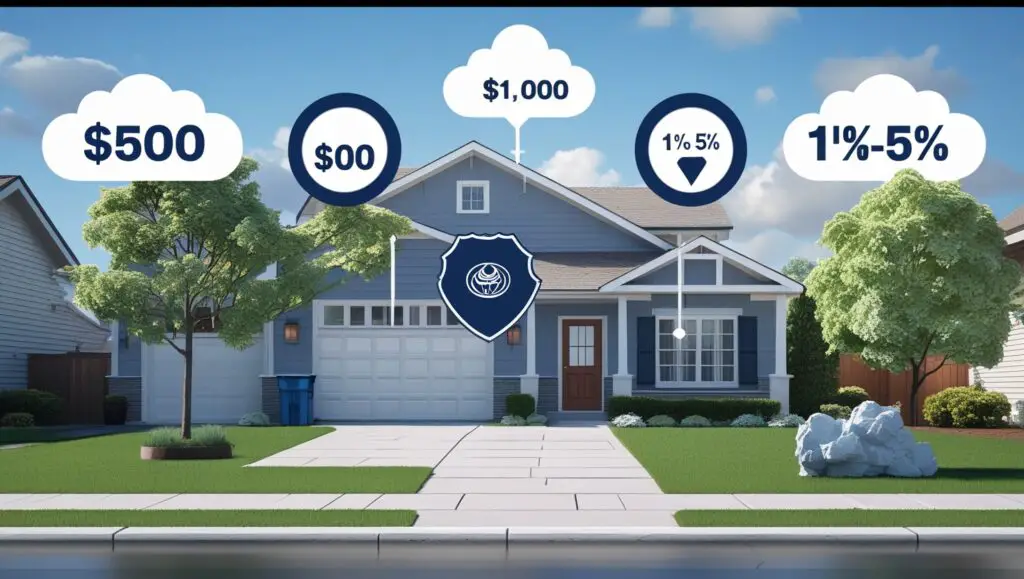Table of Contents
Introduction: Your Deductible Could Cost You More Than You Think
Imagine waking up to a burst pipe flooding your living room or a tree crashing through your roof during a storm. You call your insurance company—Allstate—and file a claim, only to realize your deductible is higher than expected. That’s when the numbers start to matter.
Understanding how much an Allstate home insurance deductible is can help you avoid financial surprises and make more informed coverage decisions. In this guide, we’ll break down how Allstate’s deductibles work, what factors affect the amount, and how you can choose the right one for your situation.
Let’s dive into the numbers behind your insurance.

What Is a Home Insurance Deductible?
Before we zero in on Allstate specifically, let’s clarify what a deductible is in home insurance.
A deductible is the amount of money you agree to pay out-of-pocket before your insurance kicks in. For example, if you have a $1,500 deductible and a claim for $6,000 in damages, Allstate would cover $4,500.
Types of Home Insurance Deductibles
Allstate typically offers two main types:
- Fixed Dollar Deductibles: Set amounts like $500, $1,000, or $2,500.
- Percentage-Based Deductibles: A percentage (usually 1%–5%) of your home’s insured value.
Some events, like hurricanes or hailstorms, may come with mandatory percentage-based deductibles, especially in states prone to severe weather like Florida or Texas.
How Much Is Allstate Home Insurance Deductible?
Let’s get to the meat of it: how much can you expect to pay with Allstate?
Common Deductible Options from Allstate
| Deductible Type | Typical Range | When It’s Used |
|---|---|---|
| Fixed Dollar Amount | $500 to $2,500 | General perils like fire, theft |
| Percentage-Based | 1% to 5% | Wind, hail, hurricanes, named storms |
| Optional Deductibles | Up to $10,000+ | High-deductible options for lower premiums |
These numbers aren’t arbitrary—Allstate lets you choose based on your premium goals and risk tolerance.
➡️ Pro Tip: A higher deductible usually means a lower premium, but make sure you can afford to pay it out-of-pocket in case of a claim.
Real-Life Example: The Cost Difference in Action
Let’s say your home is insured for $300,000.
- With a 1% deductible, you’d pay $3,000 before insurance helps.
- With a $1,000 flat deductible, your out-of-pocket expense drops by $2,000—but your premium will likely be higher.
That means if a hailstorm damages your roof and the repair estimate is $10,000:
- At 1%, Allstate pays $7,000.
- At a $1,000 fixed deductible, Allstate pays $9,000.
This is where your budget and long-term goals come into play.
How Allstate Lets You Customize Your Deductible
Allstate is known for offering flexible policy options. When setting up or updating your policy, you’ll often be asked to choose separate deductibles for:
- Dwelling Coverage
- Wind & Hail
- Hurricane/Named Storm
- Earthquake (in certain states)
This multi-deductible setup allows better customization, but it also adds complexity. Some customers have shared online (via platforms like Reddit and NerdWallet) that they were surprised to find different deductibles for different perils.
💡 Always double-check your declarations page—it outlines each deductible and what it applies to.
Factors That Affect Your Allstate Home Insurance Deductible
Allstate, like other insurers, uses a variety of factors to determine which deductible options are available to you:
1. State Regulations
States prone to natural disasters often require percentage-based deductibles for certain events.
2. Home’s Value
Higher-value homes often have higher deductible requirements, especially for percentage-based plans.
3. Location
Live in a coastal region or Tornado Alley? Expect hurricane or wind/hail deductibles to be mandatory—and higher.
4. Claims History
Frequent past claims can lead to limited deductible options or even higher base deductibles.
5. Policy Customization
Optional coverages (like scheduled personal property or water backup) may have their own deductibles.
Should You Choose a Higher or Lower Deductible?
This is the million-dollar (or at least thousand-dollar) question. Here’s a breakdown:
✅ Choose a Higher Deductible If:
- You want lower premiums
- You have enough emergency savings
- You’re unlikely to file small claims
✅ Choose a Lower Deductible If:
- You prefer predictable costs
- You’re concerned about out-of-pocket expenses
- You live in a high-risk area where claims are likely
Table: Deductible vs. Premium Trade-Off
| Deductible Amount | Estimated Premium (Annual) | Best For |
|---|---|---|
| $500 | $1,800 – $2,200 | Low-risk homeowners wanting peace of mind |
| $1,000 | $1,400 – $1,800 | Balanced risk and affordability |
| $2,500 | $1,000 – $1,300 | Budget-focused homeowners with savings |
(Estimates based on national averages and may vary by location and policy.)
Customer Insights: What People Are Saying
Homeowners who have Allstate home insurance often share mixed experiences about deductibles:
- Redditor from Florida: “I was shocked to find out my hurricane deductible was 2%—that’s $6,000!”
- Trustpilot Reviewer: “Allstate’s deductible options are flexible, but I wish they were easier to understand upfront.”
- NerdWallet Community Member: “Opted for a higher deductible to lower my premium—worked great until I had to file a wind damage claim.”
These insights highlight the importance of not only choosing the right deductible but fully understanding what it applies to.
How to Find or Change Your Allstate Deductible
If you’re already an Allstate customer:
- Log into your account on Allstate’s website or mobile app.
- View your policy declarations page to find your current deductible(s).
- To change it, contact your Allstate agent or customer service.
If you’re shopping for a new policy, ask your agent to provide quotes for different deductible options to see how they affect your premium.
Hidden Costs: Things to Watch Out For
Even with a set deductible, other costs might come into play:
- Separate deductibles per peril (e.g., wind, fire)
- Deductible per claim, not per year
- Some coverages (like identity theft or mold) may not count toward your deductible at all
It’s crucial to read the fine print and ask questions before you’re stuck paying more than expected.
Final Thoughts: Balancing Risk, Coverage & Cost
Your deductible isn’t just a number—it’s a financial decision that can impact you at the worst possible time. With Allstate, you have flexibility, but that flexibility requires careful thought.
Ask yourself:
- Can I comfortably afford my deductible?
- Am I paying more in premiums than I should?
- Do I fully understand what each deductible applies to?
If you can answer those confidently, you’re already ahead of the curve.
Related Reading
- Does Allstate Have Home Insurance?
- Does Allstate Have Gap Insurance?
- Allstate Deductible Rewards® Explained
- Homeowners Insurance 101: What You Need to Know
Ready to Review Your Deductible?
Now’s a great time to take a closer look at your insurance policy. Whether you’re an Allstate customer or shopping around, understanding how deductibles work can save you thousands in the long run.
📢 Have questions or experiences with Allstate deductibles? Share them in the comments or reach out to your agent today.




